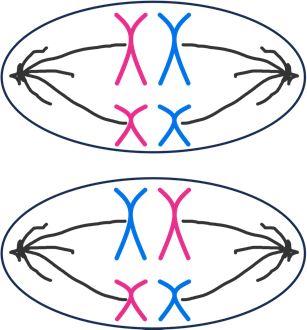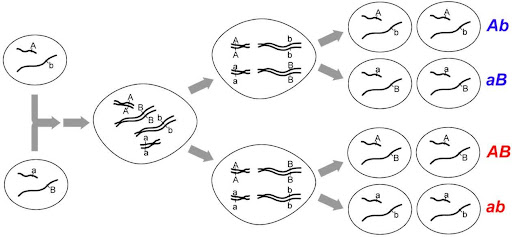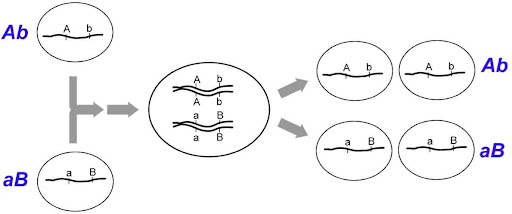Not all genes independently assort
In the module on Basic Heredity, we discussed Mendel’s Second Law: Independent Assortment. You’ll recall that Mendel observed that the heredity of separate traits (seed shape vs seed color, for example) was independent of one another.
But Mendel got a bit lucky: the seven traits he chose are on separate chromosomes. Some genes, though, located close together on the same chromosome, do not independently assort. These genes are said to be linked, and linked alleles tend to be inherited together during meiosis. This phenomenon gives geneticists a tool to map genes to particular loci on a chromosome (the singular of loci is locus, meaning location).
Remember: during meiosis 1, homologous chromosomes pair along the metaphase plate of the cell. The pairing of maternal vs paternal chromosomes is random, contributing to the independent assortment of genes on different chromosomes (Figure 3). In addition, crossing over occurs between homologous chromosomes, resulting in recombinant chromosomes, or chromosomes that are a combination of both maternal and paternal sequences. This recombination allows the independent assortment of genes that are on the same chromosome, but very far apart.


Linked genes are readily distinguished from independently assorting genes in a controlled cross. In the unit on Basic Heredity, we observed that a dihybrid testcross (AaBb x aabb) should always give a 1:1:1:1 ratio of offspring with phenotypes AB, ab, Ab, and aB. The gametes contributing to that ratio are shown in Figure 5. This is assuming independent assortment. In Figure 5, the genotypes Ab and aB are said to be parental, because these are the exact chromosomes the parental cells contributed to the dihybrid. The genotypes AB and ab are recombinant, since the original parental cells did not have that combination of alleles.
But if the genes are linked, two classes of offspring will be overrepresented, and two classes of offspring will be underrepresented. An extreme example of that is shown in Figure 6. In Figure 6, there is no recombination between genes A and B. Thus, the parental chromosomes Ab and aB are inherited intact. AB and ab genotypes are recombinant chromosomes, but recombinant chromosomes can occur only rarely if two genes are very close together (and not at all in Figure 6)


Because the rate of recombination depends on how far apart two genes are, the recombination frequency was historically used to estimate map distances on a chromosome. Let’s take a look at some examples.
Media Attributions
- Metaphase I © Amanda Simons is licensed under a CC0 (Creative Commons Zero) license
- Crossing over between homologous pairs © Amanda Simons is licensed under a CC BY-SA (Attribution ShareAlike) license
- Dihybrid inherited alleles © Nickle and Barrette-Ng via. Online Open Genetics is licensed under a CC BY-NC-SA (Attribution NonCommercial ShareAlike) license
- Genes on the same chromosomes © Nickle and Barrette-Ng via. Online Open Genetics is licensed under a CC BY-NC-SA (Attribution NonCommercial ShareAlike) license

